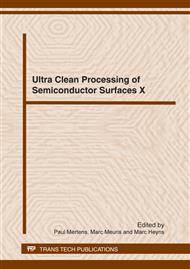p.159
p.163
p.167
p.171
p.177
p.181
p.185
p.193
p.197
Control of Sonoluminescence in Carbon Dioxide Containing Di Water at near Neutral pH Conditions
Abstract:
Light emission in sound-irradiated liquids, known as Sonoluminescence (SL), is associated with the phenomenon of cavitation that affects wafer damage during megasonic processing of wafers. It has been shown that the intensity of SL can be substantially decreased through the dissolution of carbon dioxide in deionized water. However, such dissolution decreases the pH to roughly 4.0, which is not very desirable for the removal of contaminant particles. This paper reports two chemical systems that are capable of taking advantage of the effect of CO2 while allowing the use of slightly higher pH values. Specifically, NH4OH/CO2 and NH4HCO3/dilute HCl systems have been shown to be capable of well controlled reduction in SL at pH 5.7 or 7.0. In order to test whether the free radical scavenging ability of CO2 may be responsible for its strong SL-inhibitory effect, the effect of a well known free radical scavenger, dimethyl sulfoxide (DMSO), on SL produced in DI water has been investigated.
Info:
Periodical:
Pages:
177-180
Citation:
Online since:
April 2012
Keywords:
Price:
Сopyright:
© 2012 Trans Tech Publications Ltd. All Rights Reserved
Share:
Citation:


